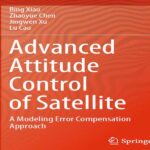- عنوان کتاب: Advanced Attitude Control of Satellite -A Modeling Error Compensation Approach
- نویسنده: Bing Xiao · Zhaoyue Chen · Jingwen Xu · Lu Cao
- حوزه: ماهواره
- سال انتشار: 2025
- تعداد صفحه: 273
- زبان اصلی: انگلیسی
- نوع فایل: pdf
- حجم فایل: 13.2 مگابایت
شکی نیست که زندگی فعلی و حتی آینده ما به شدت به ماهوارهها وابسته است. ما ماهوارهها را برای ایجاد سیستم موقعیتیابی جهانی پرتاب میکنیم تا موقعیت دقیق وسایل نقلیه بدون سرنشین و حتی بشریت را به دست آوریم. ما ماهوارهها را برای دستیابی به رصد زمین، پیشبینی آب و هوا، پیشبینی آتشسوزی، پخش ویدیویی، نظارت بر محیط زیست و غیره پرتاب میکنیم. ماهواره نقش مهمی در زندگی روزمره ما ایفا کرده است. برای ارائه چنین خدماتی به بشر، سیستم کنترل وضعیت باید برای ماهواره توسعه یابد. در غیر این صورت، محمولههایی مانند دوربینها، آنتنها و غیره به طور کامل کار نخواهند کرد. در طراحی سیستم کنترل وضعیت، طراحی کنترلکننده وضعیت یکی از مهمترین بخشها است. اگرچه کنترلکنندههای مبتنی بر نظریه کنترل خطی، از جمله قانون کنترل تناسبی-انتگرالی-مشتقی و انواع آن، به طور گسترده در مهندسی کنترل وضعیت ماهواره مورد استفاده قرار گرفتهاند، اما برای ماهوارههای مدرن که نیاز به عملکرد کنترلی بالا دارند، نامناسب میشوند. دلیل این امر این است که دینامیک هر ماهواره ذاتاً غیرخطی است. با الهام از عملکرد برتر تضمین شده توسط نظریه کنترل غیرخطی، رویکردهای کنترل وضعیت غیرخطی بسیاری برای ماهوارهها پیشنهاد شده است. با این حال، مشکل طراحی یک کنترلکننده غیرخطی برای انجام مانورهای وضعیت با عملکرد کنترلی بالا هنوز حل نشده است. علاوه بر دینامیک غیرخطی سیستم وضعیت ماهواره، خطای مدلسازی یکی دیگر از موانع اصلی است. این امر ناگزیر بر دینامیک وضعیت ماهواره تأثیر میگذارد. این امر عمدتاً از اینرسی نامشخص و مدلسازی نشده، ارتعاش انعطافپذیر غیرقابل اندازهگیری و کوپلینگ بین قسمت صلب و انعطافپذیر ماهواره، خطای محرک، عدم همترازی محرک و گشتاورهای اختلال محیطی شامل گشتاور گرادیان گرانشی، گشتاور آیرودینامیکی، گشتاور مغناطیسی زمین و گشتاور فشار تابش خورشیدی ناشی میشود. با توجه به فناوری مدلسازی محدود فعلی، خطای مدلسازی ناشناخته و حتی متغیر با زمان است. در عمل، اگر خطای مدلسازی به طور مناسب مدیریت و جبران نشود، عملکرد کنترل وضعیت بدتر میشود و حتی ممکن است ناپایداری سیستم کنترل وضعیت ایجاد شود. این امر منجر به علاقه شدید به توسعه رویکردهای کنترل جبران خطای مدلسازی شده است که قرار است این مشکل را حل کنند. از نقطه نظر رد، تضعیف و جبران خطای مدلسازی، در دو دهه گذشته شاهد پیشرفتهای چشمگیری در طراحی سیستم کنترل وضعیت ماهواره بودهایم. با این حال، در حال حاضر فقدان یک چارچوب کنترل یکپارچه وجود دارد. اکثر روشهای موجود میتوانند فقط یک نوع خطای مدلسازی را جبران کنند. علاوه بر این، بسیاری از آنها محدودیتهای فیزیکی و هزینهای مانند محدودیت محرک و سرعت زاویهای غیرقابل اندازهگیری ناشی از خرابی ژیروسکوپ را در نظر نمیگیرند. از سوی دیگر، ممکن است در طول مراحل بحرانی ماموریت در ادبیات، در طول جبران خطای مدلسازی، الزام مانور سریع وضعیت در نظر گرفته نشود. علاوه بر این، کنترلکنندههای وضعیت مقاوم یا تطبیقی موجود با در نظر گرفتن خطای مدلسازی، با محافظهکاری شدید مشخص میشوند. این امر منجر به مصرف انرژی بیشتر و در نتیجه کاهش طول عمر ماهواره خواهد شد. در مهندسی هوافضا، این مسائل باید به طور همزمان مورد بررسی قرار گیرند. با توجه به تقاضای کنترل وضعیت با چالشهای حل شده فوق و ناتوانی بسیاری از رویکردهای موجود در دستیابی به این هدف، این کتاب تلاش میکند تا چالش فوق را در طول طراحی سیستم کنترل وضعیت ماهواره حل کند. این کتاب بر طراحی تکنیکهای پیشرفته کنترل جبران برای انواع بیشتری از خطای مدلسازی با مانور وضعیت سریع، با دقت بالا، پایداری بالا و یا بدون سرعت برای ماهواره تمرکز دارد. این کتاب ابتدا بر توسعه راهحلهای غیرخطی مقاوم برای دو یا بیش از دو نوع مسئله کنترل وضعیت جبران خطای مدلسازی ماهواره حتی در حضور محدودیت محرک و خطا تمرکز دارد. تمرکز آن بر طراحی رویکردهای پیشرفته برای دستیابی به کنترل چرخش سریع وضعیت برای ماهواره با دو یا بیش از دو نوع خطای مدلسازی است که به صورت تطبیقی جبران میشوند. در نهایت، سه رویکرد جدید مبتنی بر ناظر برای انجام کنترل وضعیت ماهواره سنتز میشوند، در حالی که خطای مدلسازی به طور دقیق و کامل جبران میشود. کنترلکننده مربوطه محافظهکاری کمتری دارد و حتی هیچ محافظهکاری ندارد. هنگام استفاده از آنها برای انجام مانور وضعیت، انرژی صرفهجویی میشود. به طور خاصتر، اثربخشی و عملکرد برتر کنترل وضعیت آن دسته از رویکردهای جبران خطای مدلسازی که در این کتاب پیشنهاد شدهاند، توسط شبیهسازی عددی و آزمایشهای تجربی از طریق چندین بستر آزمایشی روی زمین تأیید میشوند. خود کتاب، وضعیت فعلی هنر در حوزه کنترل وضعیت غیرخطی ماهواره صلب یا انعطافپذیر با خطای مدلسازی را در اختیار خواننده قرار میدهد. علاوه بر این، شامل نمایش وضعیت، مدل سیستم وضعیت ماهواره شامل … نیز میشود.
There is no doubt that our current and even future lives are highly connected to satellite. We launch satellites to establish the global positioning system to get the precise position of the unmanned vehicles and even the mankind. We launch satellites to achieve Earth observation, weather forecast, fire forecast, video broadcasting, environmental monitoring, etc. Satellite has played an important role in our daily life. To provide such services for mankind, the attitude control system should be developed for satellite. Otherwise, the payloads such as cameras, antennas, etc., will not work perfectly. In the attitude control system design, attitude controller design is one of the most important parts. Although the linear control theory-based controllers including the proportional–integral–derivative control law and its variants have been widely used in satellite attitude control engineering, they are becoming inappropriate for modern satellites demanding high control performance. That is because the dynamics of any satellite is inherently nonlinear in nature. Inspired by the superior performance ensured by nonlinear control theory, many nonlinear attitude control approaches have been proposed for satellites. However, the problem of designing an nonlinear controller to accomplish attitude maneuvers with high control performance is still open. In addition to the nonlinear dynamics of the satellite attitude system, modeling error is another main hindrance. This inevitably acts on the satellite attitude dynamics. It mostly comes from uncertain and unmodeled inertia, unmeasurable flexible vibration and coupling between the rigid and the flexible part of the satellite, actuator fault, actuator misalignment, and the environmental disturbance torques including the gravity-gradient torque, the aerodynamic torque, the Earth magnetic torque, and the solar radiation pressure torque. Due to the current finite modeling technology, the modeling error is unknown and even time-varying. In practice, if the modeling error is not appropriatly handled and compensated, the attitude control performance will be deteriorated and even the instability of the attitude control system may be resulted. This has led to intense interest in the development of modeling error compensation control approaches, which are supposed to solve this problem. From the standpoint of rejecting, attenuating, and compensating for modeling error, significant developments have been witnessed for the satellite attitude control system design in the past two decades. However, there is currently a lack of a unified control framework. Most of the existing methods can compensate for a single type of modeling error only. In addition, many of them do not consider physical and cost limits such as actuator constraint and unmeasurable angular velocity due to gyro failure. On the other hand, fast attitude maneuvering requirement may not be considered during critical phases of the mission in the literature during modeling error compensation. Moreover, the existing robust or adaptive attitude controllers with modeling error accommodated are characterized by severe conservativeness. This will lead to more energy consumption, and thus reduce the lifespan of a satellite. In aerospace engineering, those issues should be addressed simultaneously. Motivated by the demand for attitude control with the above challenges solved and many existing approaches are unable to achieve this goal, this book attempts to solve the above challenge during satellite attitude control system design. This book focuses on designing advanced compensation control techniques for more types of modeling error with fast, high-accuracy, high-stability, and or velocity-free attitude maneuvering accomplished for satellite. This book first concentrates on developing nonlinear robust solutions to two or more than two types of modeling error compensation attitude control problem of satellite even in the presence of actuator constraint and fault. Its focus comes to design advanced approaches to achieve fast attitude slewing control for satellite with two or more than two types of modeling error compensated adaptively. Finally, three new observer-based approaches are synthesized to accomplish attitude control for satellite, while the modeling error is precisely and fully compensated. The corresponding controller has less and even no conservativeness. Energy is saved when they are applied to perform attitude maneuvering. More specifically, the effectiveness and the superior attitude control performance of those modeling error compensation approaches proposed in this book are verified by numerical simulation and experimental tests via several testbeds on the ground. The book itself provides the reader with the current state of the art in the nonlinear attitude control area of rigid or flexible satellite with modeling error. Moreover, it also contains the attitude representation, model of satellite attitude system including the attitude kinematics and the attitude dynamics, some fundamental definitions, and lemmas used in nonlinear control theory. Hence, this book can be used as a reference by satellite control engineers and satellite attitude control academic researchers. The book also has readers who are interested in attitude control of other rigid bodies such as unmanned aerial or underwater vehicles. Prerequisites for understanding the book are a sound of knowledge of basic nonlinear control theory especially the Lyapunov stability analysis, rigid body attitude dynamics, basic mathematics, and fundamental physics.
این کتاب را میتوانید از لینک زیر بصورت رایگان دانلود کنید:
Download: Advanced Attitude Control of Satellite




































نظرات کاربران